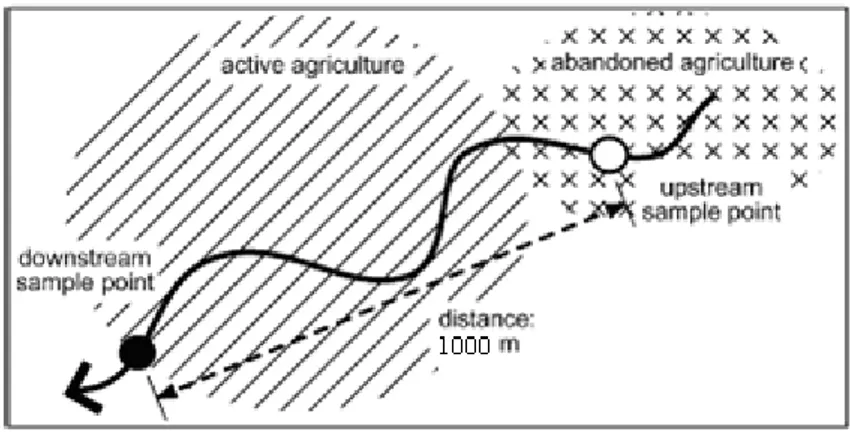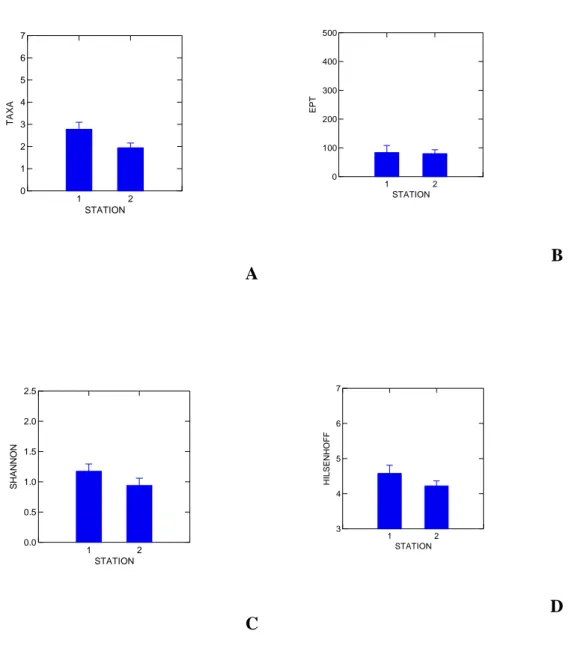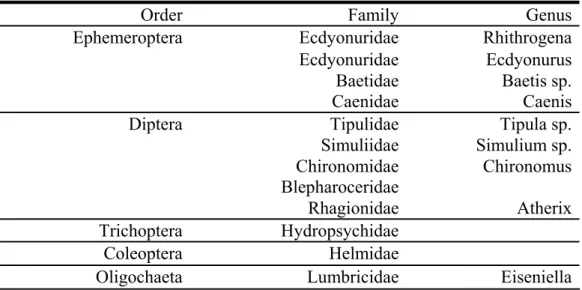SURVEY EFFECTS OF AGRICULTURAL
RUNOFF ON WATER QUALITY WITH BIOTIC
INDICES
(Case Study: Keselian River- North of Iran)
Abbas jafari
Young Researchers Club, Islamic Azad University, Ghaemshahr, Iran
Mahmoud Karami
Prof. of Tehran University, Department of Environmental Sciences and
Fisheries, Tehran, Iran
Asghar Abdoli
Prof. of Beheshti University, Department of Environment, Tehran, Iran
Ghasem Mortezaii
Prof. of Iranian Academic Center for Education, Culture and Research
(ACECR), Tehran, Iran
ABSTRACT
Biological and ecological study of water resources is the most fundamental issue in scientific researches and studies of ecosystems. Agricultural water that includes organic substances affects the quality of river water, and studying the biological community of the river is one of the ways to study the degree of this effect. The structure of macro invertebrate was studied from April to August of 2009 in two stations before and after rice-farmed fields. Results showed that sensitive groups decreased and biological indices include EPT, Hisenhoff and Shanoon faced fluctuation as well.
KEYWORDS
Agricultural runoff, Water quality, Biological indices 1 INTRODUCTION
Macroinvertebrates are integrally linked to aquatic habitats and their abundance and community structure are related to both chemical and physical in-stream conditions, making them useful biological indicators [12,15,27]. Macroinvertebrates are directly influenced by physical conditions such as substrate type, channel morphology, amount and type of detritus and aquatic vegetation and canopy cover [22,23,25] and are indirectly affected by changing nutrient concentrations and shifts in primary productivity [32,26]. Unlike water quality measurements, which only provide an instantaneous assessment of stream conditions, macroinvertebrate assemblages can be used to identify past disturbances and toxic effects that
The distribution of macroinvertebrate taxa and densities in agricultural headwater streams is influenced by many
factors, such as organic pollution [35], habitat degradation [13,24], and pesticides[29].
The input of materials from agricultural fields produces marked short-term changes of the abi- otic conditions in headwater streams. In addition to an increased hydraulic stress[10,7] there are increased concentrations of suspended particulates[14,16], nutrients [33,3] and pesticides[4,11,34].
Non-point-source agricultural pollution is regarded as the greatest threat to the quality of surface waters in rural areas [19]. The most important routes leading to non-point-source pesticide contamination of aquatic systems are runoff and spraydrift [8]. Of all non-pointsource pollutants, insecticides are among the most crucial chemical stressors because of their extremely high toxicity to many non-target aquatic organisms [5]. However, it has been shown that there are almost no studies dealing with insecticide effects on invertebrate communities under field conditions [28]. Deleterious effects have been reported during transient peaks of parathion-ethyl in a small eadwater stream in northern Germany [4]. Recent studies by Leonard et al. [17] indicated effects of the cotton insecticide endosulfan on river invertebrates in Eastern Australia.
In this study, we investigated the effects of runoff from agricultural fields by comparing the benthic macroinvertebrate communities of paired sites upstream and downstream of farms along one stream.
2 MATERIALS AND METHODS 2.1 Study Area
This study has been done in Keselian River one of the most important branch of the Telar River full of Forum (the following major areas of the southern Caspian areas) which is current in mazandaran province. The river emanate from the heights of Mount Si Saman Alborz mountain range with 1596 meters height and waters village such as Sangdeh, Pashakla, Matekola , Kchyd, Shirgah Amirkola.
All sampling sites were unshaved and situated at low altitudes (o60m asl). They were low gradient (o1%) streams with substrate of mixed sand and cobbles, and a discharge between 0.1 and 0.25ms_1. Water depths varied between 8 and 20 cm and the width of the wetted channel ranged from 200 to 300 cm.
In this stream, an upstream site surrounded by abandoned fields was compared to a downstream section where there was active agriculture (Fig. 1). Apart from this difference, sites were selected to be similar in physical aspect, riparian features and substrate. To minimise the confounding effects of longitudinal variation, the upstream and the downstream sample point were not more than 1000m apart. No point sources of pollution were evident
Figure 1. Schematic diagram of the sampling strategy in Keselian River 2.2 Sampling and data analysis
Three replicate benthic samples were taken at each site on each date. Samples were taken with surber sampler and preserved in 70% ethanol. Samples were sorted to species or orphospecies and counted.Then samples identified by identification keys [6,20,21,36], it was calculated the Shanon, EPT, total Taxa and Hilsenhof index and these data were analysed with EXELL, SPSS and SYSTAT software
3 RESULTS AND DISCUSSION
The aquatic macro invertebrate community at the study sites was quite diverse, supporting the impression gained from water-quality measurements. Diptera, Ephemeroptera, Tricoptera and Coleoptera larvae were dominant, while Plecoptera were absent.
There were differences in the number of macroinvertebrate taxa collected in upstream versus downstream sites in March (Fig. 2 A). Number of taxa in the downstream site in this Stream less than upstream.
1 2 STATION 0 100 200 300 400 500 E P T 1 2 STATION 0 1 2 3 4 5 6 7 T A X A A B C D
Figure 2. (A) Mean number (±SE ) of taxa, (B) Mean number (±SE ) of EPT, (C) Mean
number (±SE ) of Shanon and (D) Mean number (±SE ) of Hilsenhof in the upstream and
the downstream sampling points of Streams in March to August 2010.
1 2 STATION 0.0 0.5 1.0 1.5 2.0 2.5 S H A N N O N 1 2 STATION 3 4 5 6 7 H IL SE N H O F F
Table 1. List of all taxa at sampling sites.
Our investigation shows that agricultural runoff had a significant effect on the benthic community of Keselian River. This effect was evident from a comparison of upstream and downstream sites in the stream. Runoff from agricultural fields in temperate latitudes is known to cause short-term changes in abiotic conditions in streams; in particular,increases in hydraulic stress [10] and suspended sediment loads [16]. Although these factors may cause reductions in benthic fauna,especially as a result of substrate displacement (e.g. [31,1]), it is unlikely that the magnitude of this effect would have varied systematically between the upstream and the downstream sites. Agricultural field runoff includes nutrients [3] andpesticides [31,35]. Both may degrade the water quality dramatically. To our knowledge,no instance in which nutrients cause short-term toxic effects has been reported in the literature. However,short-term contamination by pesticides has well-documented toxic effects on aquatic communities [2,9,18]. Schulz and Liess [28] provide an overview of field studies undertaken in temperate latitudes that establish a relationship between insecticide contamination and consequent effects on aquatic fauna.
4 ACKNOWLEDGEMENTS
This study was financed by Young Researchers Club, Islamic Azad University, Ghaemshahr Branch.
REFERENCES
[25]
[26] [1] Cobb DG,Flannaga n JF. 1990. Trichoptera and substrate stability in the Ochre River,Manitoba. Hydrobiologia;206:29–38.
[27] [2] Cooper CM. 1993. Biological effects of agriculturally derived surface-water pollutants on aquatic systemsFa review. J Environ Qual;22:402–8.
[28] [3]Cooper CM,Lipe WM. 1992. Water quality and agriculture: Mississipi experiences. J Soil Water Conserv;47: 220–3.
Genus Family Order Rhithrogena Ecdyonuridae Ephemeroptera Ecdyonurus Ecdyonuridae Baetis sp. Baetidae Caenis Caenidae Tipula sp. Tipulidae Diptera Simulium sp. Simuliidae Chironomus Chironomidae Blepharoceridae Atherix Rhagionidae Hydropsychidae Trichoptera Helmidae Coleoptera Eiseniella Lumbricidae Oligochaeta
[30] [5] Feei S. 1987. Evaluating acute toxicity of pesticides to aquatic organisms carp, mosquito fish and daphnids. Plant Prot Bull (Taiwan, R.O.C.);29:385–96.
[31] [6] Fitler, R and Manuel .R .1966. Fresh water life of Britain and North-West Europe. Collins sons&Glasgow .p:390.
[32] [7] Gomme, J.W., Shurvell, S., Hennings, S.M., Clark, L., 1991. Hydrology of pesticides in a chalk catchment-surface waters. J. Inst. Wat. Environ. Manage. 5, 546– 553.
[33] [8] Groenendijk P, van der Kolk JWH, Travis KZ. 1994. Prediction of exposure concentration in surface waters. In: Hill IR, Heimbach F, Leeuwangh P, Matthiessen P, editors.Freshwater field tests for hazard assessment of chemicals. Boca Raton: Lewis Publisher; p. 105–25.
[34] [9] Heckman CW. 1982. Pesticide effects on aquatic habitats. Environ Sci Technol;16:48A–57A.
[35] [10] Higler LWG,Repko FF. 1981. The effects of pollution in the drainage area of a Dutch lowland stream on fish and macroinvertebrates. Verh Inernat Verein Limnol;21:1077–1082.
[36] [11] Hill, R., 1989. Aquatic organisms and pyrethroids. Pestic. Sci. 27, 429–465.
[37] [12] Hilsenhoff, W.L., 1987. An improved biotic index of organic stream pollution. Gt. Lakes Entomol. 20 (1), 31-39.
[38] [13] Hilsenhoff, W.L., 1977. Use of Arthropods to Evaluate Water Quality of Streams. Technical Bulletin. Department of Natural Resources, Madison, WI, USA.
[39] [14] Hogg, I.D., Norris, R.H., 1991. Effects of runoff from land clearing and urban development on the distribution and abundance of macroinvertebrates in pool areas of a river. Aust. J. Mar. Freshwat. Res. 42, 507–518.
[40] [15] Knorr, D.F., Fairchild, G.W., 1987. Periphyton, benthic invertebrates and fishes as biological indicators of water quality in the East Branch Brandywine Creek. Proc. Pa. Acad. Sci. 61, 61-66.
[41] [16] Kuhnle, R.A., 1992. Bed load transport during rising and falling stages on two small streams. Earth Surface Processs Landforms 17, 191–197.
[42] [17] Leonard AW, Hyne RV, Lim RP, Pablo F, Van den Brink PJ. 2000. Riverine endosulfan concentrations in the Namoi River, Australia: link to cotton field runoff and macroinvertebrate population densities. Environ Toxicol Chem;19:1540–51.
[43] [18] Liess M,Schulz R. 1999. Linking insecticide contamination and population response in an agricultural stream. Environ Toxicol Chem;18:1948–55.
[44] [19] Loague K, Corwin DL, 1998. Ellsworth TR. The challenge of predicting nonpoint source pollution. Environ Sci Technol;32:130–3.
[45] [46]
[47] [20] Macan ,T .T. 1970. A guide to fresh water invertebrates animals.print. Britain by Lowe and Brydoon. Ltd, Lond. N. p.116.
[48] [21] Mellanby, H. 1963. Animal life in fresh water. A guide to fresh water in vertebrates. London mthuem. P. 308.
and Fish. EPA 440-4-89-001. US Environmental Protection Agency, Office of Water Regulations and Standards, Washington, DC, USA.
[52] [25] Richards, C., Host, G.E., Arthur, J.W., 1993. Identification of predominant environmental factors structuring stream macroinvertebrate communities within a large agricultural catchment. Freshwater Biol. 29, 285-294.
[53] [26] Richards, C., Johnson, L.B., Host, G.E., 1996. Landscape-scale influences on stream habitats and biota. Can. J. Fish. Aquat. Sci. 53, 295-311.
[54] [27] Rosenberg, D.M., Resh, V.R., 1993. Freshwater Biomonitoring and Benthic Macroinvertebrates, Chapman & Hall, New York.
[55] [28] Schulz R, Liess M. 1999. A field study of the effects of agriculturally derived insecticide input on stream macroinvertebrate dynamics. Aquat Toxicol;46:155–76. [56] [29] Schulz, R., Liess,M., 1999. A field study of the effects of agriculturally derived
insecticide input on stream macroinvertebrate dynamics. Aquat. Toxicol. 46, 155–176. [57] [30] Schulz R, Hauschild M,Ebeling M,Nanko-Drees J, Wogram J,Liess M. 1998. A
qualitative field method for monitoring pesticides in the edge-of-field runoff. Chemosphere;36:3071–82.
[58] [31] Statzner B. 1981. The relation between hydraulic stress and microdistribution of benthic macroinvertebrates in a lowland running water system,the Schierenseebrooks (North Germany). Arch Hydrobiol;91:192–218.
[59] [32] Stewart, P.M., Robertson, D.J., 1992. Aquatic organisms as pollution indicators of water quality in suburban streams of the Lower Delaware River Region. USA. Proc. Pa. Acad. Sci. 66, 135- 141.
[60] [33] Walther, W., 1980. Prozess des Stoffabtrages und der Stoffauswaschung wa¨hrend und nach Starkregen in ackerbaulich genutzten Gebieten-1. Bericht: Stoffabtrag. Z. Kulturtech. Flurberein. 21, 65–74.
[61] [34] Wauchope, R.D., 1978. The pesticide content of surface water draining from agricultural fields—a review. J. Environ. Qual. 7, 459–472.
[62] [35] Whitehurst, I.T., 1991. The Gammarus–Asellus ratio asan index of organic pollution. Water Res. 25, 333–340.
[63] [36] William ,D .D. and Feltmate, B .W. 1992. Aquatic insects. Printed and bound in the UK by Red Wood press Ltd. Melksham . p. 356.


